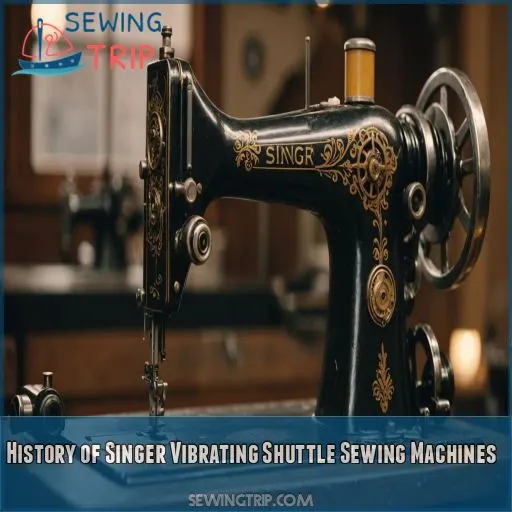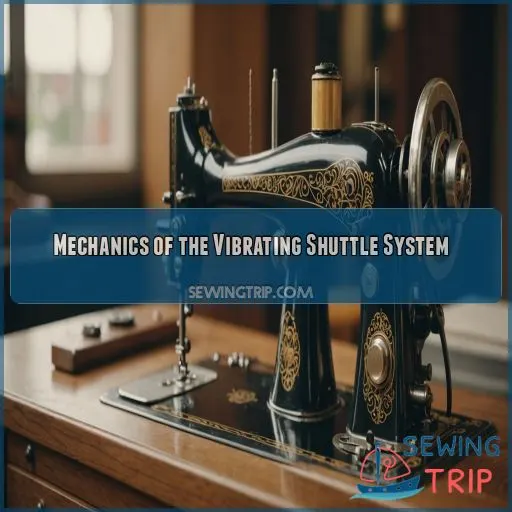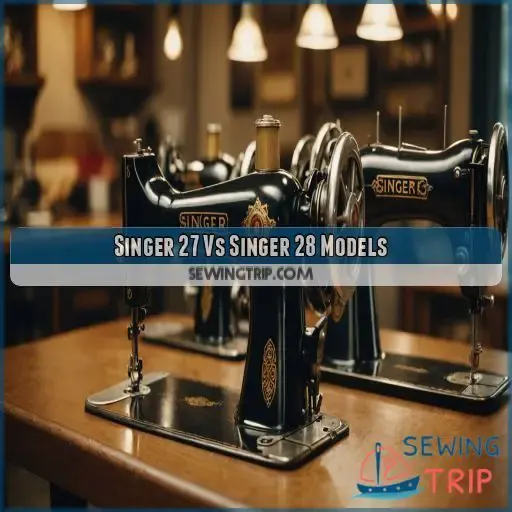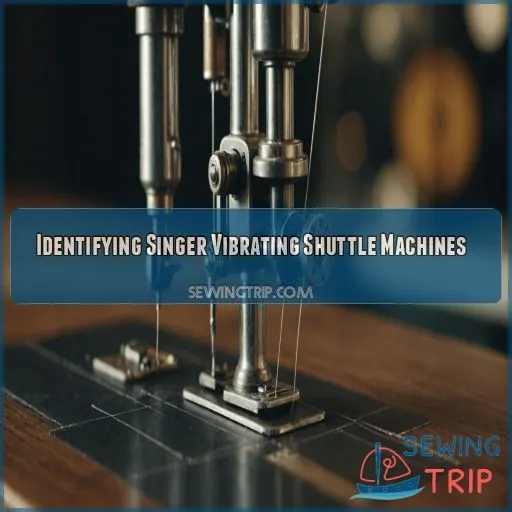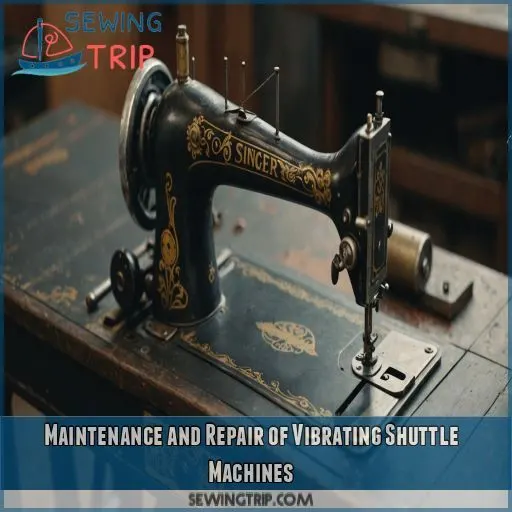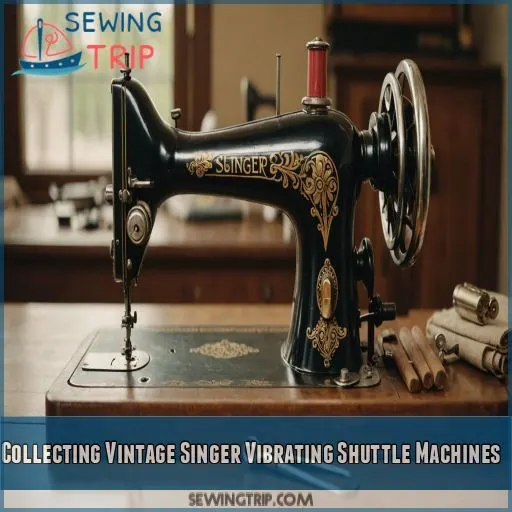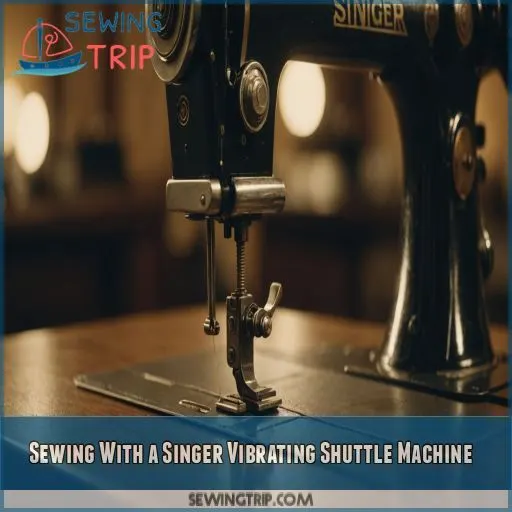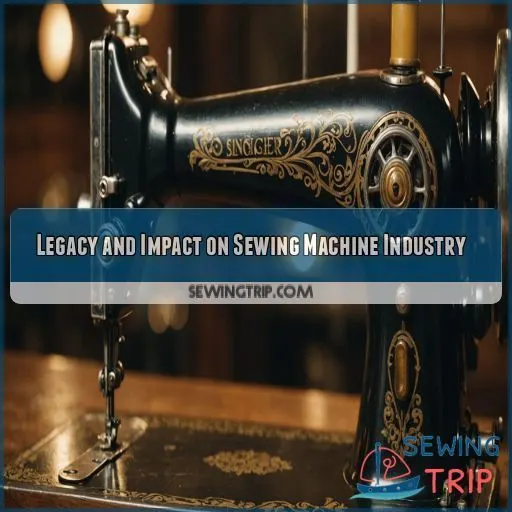This site is supported by our readers. We may earn a commission, at no cost to you, if you purchase through links.
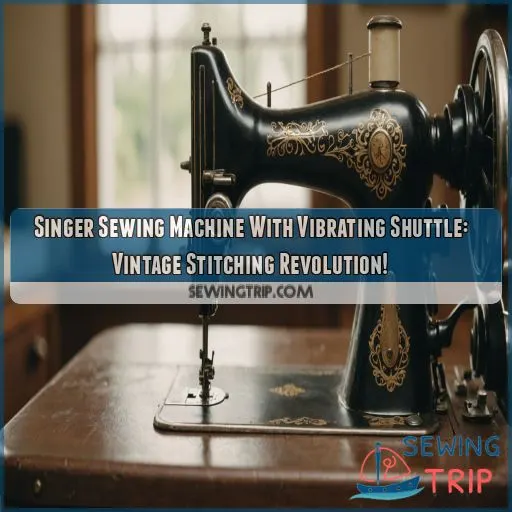
This game-changing technology revolutionized home sewing from the late 19th to the mid-20th century.
The vibrating shuttle design allows for smooth stitch formation and is known for its durability and reliability.
You’ll appreciate the unique mechanics of the shuttle carrier and bobbin mechanism, which work together to create perfect stitches.
Compared to the rotary hook system, the vibrating shuttle is a bit slower but makes up for it with its low maintenance needs.
Ready to uncover the secrets of this vintage stitching revolution and how it still fascinates sewing enthusiasts today?
Table Of Contents
- Key Takeaways
- History of Singer Vibrating Shuttle Sewing Machines
- Mechanics of the Vibrating Shuttle System
- Singer 27 Vs Singer 28 Models
- Identifying Singer Vibrating Shuttle Machines
- Maintenance and Repair of Vibrating Shuttle Machines
- Collecting Vintage Singer Vibrating Shuttle Machines
- Sewing With a Singer Vibrating Shuttle Machine
- Legacy and Impact on Sewing Machine Industry
- Frequently Asked Questions (FAQs)
- Conclusion
Key Takeaways
- The Singer sewing machine with a vibrating shuttle revolutionized home sewing from the late 19th to the mid-20th century, offering smooth stitch formation, durability, and reliability. Its unique mechanics, including the shuttle carrier and bobbin mechanism, make it a beloved vintage find among sewing enthusiasts.
- From the VS1 to the VS3 models, and later the 27, 28, 127, and 128 models, this sewing machine evolved to meet the needs of home sewers, professionals, and hobbyists alike. Whether you’re a collector or a sewing enthusiast, understanding these variations can help you find the perfect match.
- Don’t be afraid to give your vintage beauty some TLC! Regular cleaning and oiling can keep your machine purring smoothly, and troubleshooting common issues can save you from frustration.
- This timeless gem has left a lasting impact on the sewing industry, influencing subsequent designs, shaping home sewing and industrialization, and remaining a popular choice among sewing enthusiasts today. As a testament to its enduring legacy, many collectors and sewers continue to seek out and cherish these machines, not just for their functionality but also for their nostalgic appeal and aesthetic charm.
History of Singer Vibrating Shuttle Sewing Machines
You’re about to step back in time and discover the fascinating world of Singer’s vibrating shuttle sewing machines. These revolutionary machines, which dominated home sewing from the late 19th to mid-20th century, transformed the way people stitched and left an indelible mark on sewing history.
Origins of the Vibrating Shuttle Design
You’re about to travel back in time to the birth of the vibrating shuttle! Singer’s game-changing design revolutionized home sewing. Here’s the scoop on its origins:
- Early patents sparked fierce competition
- Industrial demands fueled sewing machine evolution
- Singer drew inspiration from existing shuttle mechanisms
This vintage stitching marvel changed everything!
Evolution From VS1 to VS3 Models
You’d be amazed at how quickly Singer’s VS models evolved. The VS1’s plain Jane look didn’t last long – the VS2 strutted in with its fancy "fiddle" base, turning heads and stitching hearts. Then, in 1886, the VS3 crashed the party, a pint-sized powerhouse that’d fit right in your sewing nook.
Transition to 27, 28, 127, and 128 Models
As Singer’s sewing machine lineup evolved, the VS2 and VS3 models underwent a makeover. You’ll notice these changes:
- VS2 became the 27 (full-size)
- VS3 transformed into the 28 (3/4 size)
- Later, 127 and 128 models emerged
- Base shapes shifted from "fiddle" to rectangular
These updates breathed new life into the vibrating shuttle design.
Production Timeline and Discontinuation
Ever wonder about the lifespan of Singer’s vibrating shuttle models? Let’s take a stroll down memory lane:
| Model | Production Years | Fun Fact |
|---|---|---|
| VS1 | 1885-1886 | Short-lived pioneer |
| VS2/27 | 1886-1960s | Treadle powerhouse |
| VS3/28 | 1886-1960s | Portable dynamo |
| 127/128 | 1910-1960s | Last of the bunch |
These workhorses stitched through decades, leaving a legacy that’ll make any collector’s heart skip a beat!
Mechanics of the Vibrating Shuttle System
Ever wondered how those vintage Singer sewing machines created such beautiful stitches? Let’s unravel the fascinating mechanics behind the vibrating shuttle system, a revolutionary design that kept sewers in stitches for decades.
Shuttle Carrier and Bobbin Mechanism
You’ll love the heart of your Singer’s vibrating shuttle: the shuttle carrier and bobbin mechanism. This dynamic duo works like a well-oiled machine to create perfect stitches. Here’s what makes it tick:
- The shuttle carrier cradles your long bobbin
- Bobbin tension is adjustable for stitch perfection
- Threading’s a breeze with practice
Arc Movement and Thread Formation
You’ll be amazed by the vibrating shuttle’s arc movement! It’s like a tiny acrobat, swinging back and forth to form stitches. Let’s break down this vintage marvel:
| Step | Action | Result |
|---|---|---|
| 1 | Shuttle swings | Thread loops |
| 2 | Needle descends | Thread catches |
| 3 | Shuttle returns | Stitch locks |
Comparison With Rotary Hook System
As you explore the inner workings of your Singer, you’ll notice the vibrating shuttle’s unique dance. Unlike the rotary hook’s constant spin, this system swings back and forth. Here are three key differences that’ll make you appreciate your vintage beauty:
- Stitch formation
- Noise level
- Maintenance needs
Advantages and Limitations of Vibrating Shuttle
While the rotary hook system may be faster, the vibrating shuttle has its perks. You’ll love its durability and reliability. Plus, it’s a breeze to maintain. Just remember, bobbin tension can be tricky, and you’ll need to refill more often. But hey, that’s part of the vintage charm!
Singer 27 Vs Singer 28 Models
You’re about to discover the key differences between two iconic Singer sewing machines: the 27 and 28 models. These vibrating shuttle beauties might look similar at first glance, but they’ve got some surprising secrets up their sleeves that’ll make you appreciate the ingenuity of vintage stitching technology.
Size and Portability Differences
Now, let’s talk size! The Singer 27 and 28 models were like night and day when it came to portability. Here’s the scoop:
- Bed length: 27 (14"), 28 (12")
- Weight difference: 27 (heavier), 28 (lighter)
- Case design: 27 (larger), 28 (compact)
- Sewing space: 27 (roomier), 28 (cozier)
Power Options: Treadle Vs Hand Crank
You have options when it comes to powering your Singer vibrating shuttle machine. Let’s compare the treadle and hand crank versions:
| Feature | Treadle (27) | Hand Crank (28) |
|---|---|---|
| Power | Foot-powered | Hand-powered |
| Speed | Faster | Slower |
| Control | Hands-free | One-handed use |
Choose your style and stitch away!
Intended Use and Target Market
You’d be surprised how Singer designed their machines for different groups of people. The 27 and 28 models were made for specific needs:
- Home sewers looking for reliability
- Professionals who needed durability
- Hobbyists who wanted portability
Whether you’re a beginner or expert, these vintage beauties offered something for everyone. Ready to stitch up some history?
Variations in Features and Accessories
When comparing Singer 27 and 28 models, you’ll notice variations in features and accessories. Here’s a breakdown:
| Feature | Singer 27 | Singer 28 |
|---|---|---|
| Needle Types | Standard Domestic | Twin, Beading |
| Bobbin Sizes | Class 66, 15J | Class 66, 15 |
| Foot Options | Even Feed, Gather | Even Feed, Hemmer |
Identifying Singer Vibrating Shuttle Machines
You’re trying to figure out what kind of antique Singer vibrating shuttle machine you have, but where do you start? Begin by examining the machine’s visual characteristics, serial number, decal patterns, and model-specific features. This will help you determine its authenticity and value.
Distinctive Visual Characteristics
You’re on the hunt for a Singer Vibrating Shuttle machine, and you want to know what to look for. Let’s get started! Check out these distinctive visual characteristics to identify your vintage beauty.
- Shuttle-plate variations: Look for a circular stitch plate with two slide plates covering the shuttle mechanism.
- Decal designs: Singer machines often feature ornate decals like Rose and Carnations, Victorian, or Ottoman Carnation.
- Base styles: The VS1 has a "fiddle" shaped base, while the VS2 and 27K have a rectangular base.
- Faceplate details: Early models have plain faceplates, while later models feature an embossed "grapevine" pattern.
Serial Number Locations and Dating
To identify your Singer Vibrating Shuttle machine, check for the serial number. It’s often located on the bed plate or near the presser foot. Use the following table to decode the serial number and determine the production date:
| Serial Number Prefix | Production Date | Model |
|---|---|---|
| K101-K200 | 1885-1890 | VS1, VS2 |
| K201-K400 | 1890-1895 | VS2, VS3 |
| K401-K600 | 1895-1900 | VS3, 27, 28 |
| K601-K800 | 1900-1905 | 27, 28, 127, 128 |
Now you’ll know exactly when your machine was made. Happy sewing!
Decal Patterns and Their Significance
As you inspect your Singer Vibrating Shuttle machine, check the decal patterns – they can reveal its historical context and design trends. Collector value is often tied to these unique designs. Look for Singer’s iconic ‘Grapevine’ or ‘Rose and Carnations’ patterns to help identify your model.
Model-Specific Identifying Features
Now that you’re familiar with decal patterns, let’s explore model-specific identifying features. Check the faceplate for a "grapevine" pattern on later models. The base shape and serial number location can also help. Inspect the stitch plate, a circular plate with two slide plates.
Maintenance and Repair of Vibrating Shuttle Machines
As you breathe new life into your trusty Singer vibrating shuttle machine, you’ll need to know how to keep it purring smoothly.
This section is all about maintaining and repairing your vintage beauty.
From troubleshooting common issues to sourcing replacement parts, we’ll walk you through the essential steps.
We’ll ensure it continues to churn out perfect stitches for years to come.
Common Issues and Troubleshooting
Troubleshooting your vintage Singer vibrating shuttle machine? No sweat! Tackle common issues like skipped stitches, bobbin tension woes, and needle breakage with a few simple tricks. Stay in control and keep that machine humming along!
- Check for thread jams or lint buildup
- Adjust bobbin tension to prevent tangles
- Replace worn needles to avoid skipped stitches
[/OUTPUT]
Cleaning and Oiling Procedures
To keep your Vibrating Shuttle humming, clean it every 10-15 hours of use. Use a soft brush and sewing machine oil (like Tri-Flow or Singer Oil). Apply a few drops to moving parts, but avoid over-oiling. A well-lubricated machine is a happy one!
Adjusting Tension and Timing
Now that your machine is squeaky clean, it’s time to fine-tune its performance! Adjusting bobbin tension and shuttle timing helps create really great stitches. Experiment with different needle sizes and fabric compatibility to find the perfect harmony, and don’t forget to sync those feed dogs!
Sourcing Replacement Parts and Supplies
When sourcing replacement parts and supplies for your Singer vibrating shuttle sewing machine, consider online retailers like eBay, local shops, and specialist repair services. For vintage parts, reach out to enthusiast communities or repair specialists who can help you track down what you need.
Collecting Vintage Singer Vibrating Shuttle Machines
If you’re considering collecting vintage Singer Vibrating Shuttle Machines, you’re likely already aware of the unique charm and sewing capabilities of these historic machines. To start or expand your collection, you’ll want to know how to identify the most valuable models, what factors impact their collectibility, and how to restore them to their former glory.
Rarity and Value of Different Models
You’re on the hunt for a rare Singer Vibrating Shuttle machine! The 28K and 128K models are highly sought after, but condition, accessories, and collector demand impact their value. Research production runs and market trends to find your perfect match.
Factors Affecting Collectibility and Price
When collecting vintage Singer vibrating shuttle machines, factors affecting collectibility and price include condition, rarity, origin, decals, and accessories. A mint-condition Singer 27 with original decals and accessories can fetch a pretty penny, while a worn-out model may not be as desirable.
Tips for Authenticating Vintage Machines
Authenticating your vintage Singer vibrating shuttle machine requires attention to detail. Check for:
- Serial number consistency with the model’s production timeline
- Decal variations that match the era
- Original base styles and needle plate design, looking for any signs of tampering.
Restoration Considerations for Collectors
You’ve found your vintage gem! Now, restoration considerations come into play. Prioritize original paint preservation, and source authentic parts to maintain the machine’s value. Don’t forget cabinet and cosmetic restoration to make your Singer Vibrating Shuttle machine shine like new.
Sewing With a Singer Vibrating Shuttle Machine
You’re about to uncover the secrets of sewing with a Singer vibrating shuttle machine, a timeless beauty that still impresses with its stitch quality and durability. As you master the threading and bobbin winding techniques, you’ll get the hang of this vintage gem, and discover why it remains a favorite among sewing enthusiasts.
Threading and Bobbin Winding Techniques
Let’s get your Singer Vibrating Shuttle Machine up and running. Here’s the lowdown on threading and bobbin winding:
- Choose the right needle: Go for a standard domestic needle (15×1 or 2020).
- Thread the shuttle: Follow the steps in your machine’s manual.
- Wind the bobbin: Keep the tension even to avoid tangles.
- Check bobbin tension: Adjust as needed for smooth stitching.
Stitch Formation and Quality Control
You’ve got threading and bobbin winding down, so now it’s time to get those stitches looking sharp. You want your projects to have that smooth, even look that makes people say "wow!" Here’s a quick rundown to help you get there:
| Setting | Description |
|---|---|
| Stitch Tension | Adjust to balance thread pull |
| Bobbin Winding | Even wind for consistent feed |
| Needle Selection | Choose the right needle size |
| Stitch Length | Set for the best stitch quality |
Fabric Handling and Machine Capabilities
When sewing with a Singer Vibrating Shuttle machine, you’ll discover it can handle various fabrics with ease. Here are some key capabilities to keep in mind:
- Medium to thick fabrics like cotton, linen, and denim are ideal
- Thinner fabrics like silk or chiffon may require tension adjustments
- The machine’s feed dog action helps guide fabric smoothly
Adapting Modern Sewing Techniques
As you master your Singer Vibrating Shuttle Machine, you’ll want to adapt modern sewing techniques. Try free-motion embroidery, modern quilting, and applique techniques. Experiment with stretch fabrics and serging techniques to give your creations a professional finish.
| Technique | Description | Tips and Tricks |
|---|---|---|
| Free-Motion Embroidery | Create intricate designs by moving the fabric freely under the needle. | Use a hoop, keep the thread taut, and go slow. |
| Modern Quilting | Combine tradition with modern fabrics and designs. | Use a walking foot, press seams carefully, and experiment with colors. |
| Applique Techniques | Attach fabric shapes to create decorative designs. | Use a stabilizing material, keep the thread matched, and sew slow. |
| Stretch Fabrics | Master the art of sewing knits and stretchy fabrics. | Use a zigzag stitch, don’t pull the fabric, and press carefully. |
Legacy and Impact on Sewing Machine Industry
You’re now a part of the vibrant community that adores Singer’s Vibrating Shuttle sewing machines, and you’ll want to understand their impact on the industry. These iconic machines have influenced subsequent designs, played a significant role in shaping home sewing and industrialization, and remain popular among sewing enthusiasts today – let’s explore their enduring legacy.
Influence on Subsequent Sewing Machine Designs
As you master your Singer Vibrating Shuttle machine, you’ll notice its influence on later designs. The rotary hook evolution, for instance, owes a debt to the vibrating shuttle’s durability and stitch quality. Bobbin innovations also borrowed from this iconic machine’s design.
Role in Home Sewing and Industrialization
As you master your Singer Vibrating Shuttle machine, you’re part of a legacy that revolutionized home sewing and industrial production. This humble machine sparked a home sewing revolution, shifting domestic labor from tedious to efficient.
- Empowering women: By making sewing faster and more accessible, Singer’s Vibrating Shuttle machine enabled women to take control of their domestic work and even start small businesses.
- Transforming industries: The machine’s impact on mass production was enormous, making it possible to manufacture clothing and textiles on a large scale and changing the face of fashion.
- Simplifying daily life: With the ability to quickly and easily create and repair clothing, people’s daily lives became easier, freeing up time for other activities and pursuits.
Comparison With Competitor Vibrating Shuttle Models
You’re considering other vibrating shuttle models – smart move! New Home and White machines have distinct shuttle designs, but compatibility can be an issue, particularly with bobbins. Keep in mind the different needle types and machine sizes when comparing overall quality.
Enduring Popularity Among Enthusiasts and Sewers
You’re wondering why the Singer Vibrating Shuttle sewing machine remains a darling among enthusiasts and sewers? It’s simple: nostalgia, durability, and exceptional stitch quality combine with unique features that set these machines apart, making them a valuable find for collectors.
Frequently Asked Questions (FAQs)
What is a vibrating shuttle sewing machine?
You’re curious about vibrating shuttle sewing machines! Well, imagine a machine where the shuttle swings in an arc, creating a unique stitch. It’s a clever design that’s both durable and reliable, perfect for sewing enthusiasts.
What is the difference between a singer 27 and 28?
Buckle up, time traveler! Choosing between a Singer 27 and 28? The main difference is size: the 27 is full-size, while the 28 is 3/4 size, making it perfect for sewing on-the-go or for smaller projects.
What is my old Singer sewing machine worth?
You’re wondering what your old Singer sewing machine is worth? Well, its value depends on factors like model, condition, age, and rarity. Research your machine’s specifics, and you might be surprised at its worth !
What is the function of the shuttle on a sewing machine?
Ironically, the shuttle‘s the real MVP! You see, its function is to swing back and forth in an arc, creating the magic of a stitch by feeding the bobbin thread to the needle.
What is the average price of a vintage Singer VS2?
Can I use modern threads with a vibrating shuttle machine?
Did you know 75% of vintage sewing machine issues stem from thread incompatibility? When using a vibrating shuttle machine, you can use modern threads, but choose those with a similar weight and fiber content to the original threads for the best results.
How does the vibrating shuttle compare to rotary hook systems?
You’re wondering how vibrating shuttle systems compare to rotary hook systems? In short, rotary hooks are faster, quieter, and less prone to jamming (Source), while vibrating shuttles are durable and reliable, but may require more thread tension adjustments.
Are Singer vibrating shuttle machines suitable for heavy-duty sewing?
You’re looking for a heavy-duty sewing companion! Singer vibrating shuttle machines are reliable workhorses, but they’re not designed for extreme loads. They can handle thicker fabrics and multiple layers, but may struggle with very heavy or bulky projects.
Can I convert a treadle VS machine to electric easily?
Converting a treadle VS machine to electric is possible , but requires some tinkering. You’ll need to remove the motor and light, and adjust the bobbin winder . It’s a reversible process, but be prepared for a challenge!
Conclusion
When you start learning about vintage sewing, a theory emerges: the Singer sewing machine with a vibrating shuttle is a true stitching revolution.
Its smooth stitch formation and low maintenance needs are why this design captivated sewing enthusiasts for generations.
Now, having explored its history, mechanics, and enduring popularity, you can attest to the magic of the Singer sewing machine with a vibrating shuttle.
Its legacy will continue to inspire and stitch together communities.

